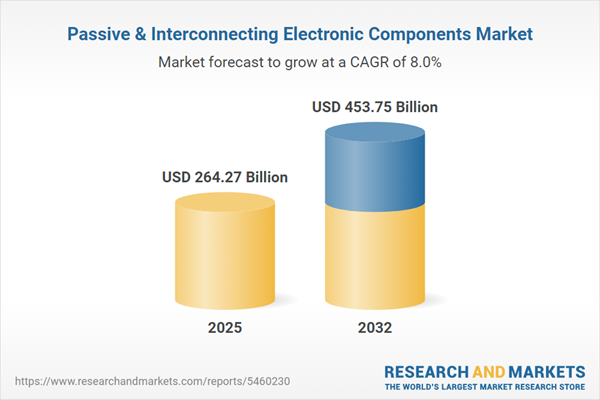Speak directly to the analyst to clarify any post sales queries you may have.
The Passive and Interconnecting Electronic Components Market is evolving rapidly, shaped by the dual forces of miniaturization and digital transformation. Industry leaders must navigate new technology trends, supply chain complexity, and stricter regulatory demands to deliver solutions that underpin next-generation electronics.
Market Snapshot of Passive & Interconnecting Electronic Components
The Passive and Interconnecting Electronic Components Market grew from USD 244.58 billion in 2024 to USD 264.27 billion in 2025. It is expected to continue growing at a CAGR of 8.03%, reaching USD 453.75 billion by 2032. This consistent upward trend reflects the surging demand for robust electronic systems across sectors, driven by the convergence of intelligent devices, sustainability initiatives, and supply chain innovation.
Scope & Segmentation
- Component Type: Capacitors, Connectors, Inductors & Transformers, Resistors, Switches & Relays
- Mounting Type: Surface Mount, Through Hole
- Dielectric Material: Aluminum Electrolytic, Ceramic, Polymer, Supercapacitor, Tantalum
- Frequency Range: Low Frequency, Radio Frequency
- Operating Temperature: High, Standard
- End User Industry: Aerospace, Automotive, Consumer Electronics, Energy, Healthcare, Industrial, Telecommunications
- Application: Circuit Protection, EMI Suppression, Power Management, Signal Filtering
- Regional Coverage: Americas (United States, Canada, Mexico, Brazil, Argentina, Chile, Colombia, Peru), Europe, Middle East & Africa (United Kingdom, Germany, France, Russia, Italy, Spain, Netherlands, Sweden, Poland, Switzerland, United Arab Emirates, Saudi Arabia, Qatar, Turkey, Israel, South Africa, Nigeria, Egypt, Kenya), Asia-Pacific (China, India, Japan, Australia, South Korea, Indonesia, Thailand, Malaysia, Singapore, Taiwan)
- Company Profiles Include: TE Connectivity Ltd., Amphenol Corporation, TDK Corporation, Murata Manufacturing Co., Ltd., Samsung Electro-Mechanics Co., Ltd., Taiyo Yuden Co., Ltd., Vishay Intertechnology, Inc., Yageo Corporation, Hirose Electric Co., Ltd., AVX Corporation
Key Takeaways for Decision-Makers
- Miniaturization combined with advanced materials is enhancing system efficiency while introducing quality assurance and sourcing complexities.
- Increasing focus on sustainability is prompting innovations in materials, recyclability, and lifecycle management, further influencing supplier selection and R&D direction.
- Digital integration—spanning smart sensors in components to AI-optimized supply chains—is transforming maintenance, forecasting, and traceability.
- Tariff regimes, such as recent U.S. tariff adjustments, have redefined sourcing strategies, pushing companies toward nearshoring, diversified supply bases, and standardization.
- Region-specific dynamics drive unique requirements: North America’s aerospace and automotive demand, Europe’s sustainability mandates, and Asia-Pacific’s scale-centric manufacturing all shape product portfolio and compliance strategies.
- Leading companies deploy digital twins, flexible manufacturing, and blockchain for compliance and operational adaptation in an increasingly interconnected marketplace.
Tariff Impact on the Passive & Interconnecting Electronic Components Market
The implementation of U.S. tariffs in 2025 catalyzed a shift in global supply strategies for components like capacitors and connectors. Businesses evolved to mitigate rising costs, investing in local and regional partnerships as well as diversifying procurement channels. This shift strengthened collaboration between engineering and procurement, encouraged production near end-users, and prompted a move toward standardizing product variants to ease certification and meet shifting regulatory requirements.
Methodology & Data Sources
This analysis applies a multi-stage approach built on secondary research, primary expert interviews, and rigorous triangulation to deliver unbiased insights. Industry publications, filings, and executive engagements establish the foundation, while scenario modeling and sensitivity analysis inform segmentation and regional forecasts. Conclusions benefit from peer reviews and alignment with historical and emerging trends.
Why This Report Matters
- Enables senior executives to anticipate shifts in market dynamics and adjust sourcing, design, and compliance strategies proactively.
- Supports innovation and operational excellence by providing deep insights into technology adoption, sustainability, and global supply trends.
- Equips organizations to fortify supply resilience and capitalize on opportunities arising from policy changes and evolving end-user requirements.
Conclusion
The passive and interconnecting electronic components market continues to transform under technological, regulatory, and global trade pressures. Those who leverage strategic agility and sustained innovation will reinforce their competitive position in this dynamic landscape.
Additional Product Information:
- Purchase of this report includes 1 year online access with quarterly updates.
- This report can be updated on request. Please contact our Customer Experience team using the Ask a Question widget on our website.
Table of Contents
3. Executive Summary
4. Market Overview
7. Cumulative Impact of Artificial Intelligence 2025
Companies Mentioned
The companies profiled in this Passive & Interconnecting Electronic Components market report include:- TE Connectivity Ltd.
- Amphenol Corporation
- TDK Corporation
- Murata Manufacturing Co., Ltd.
- Samsung Electro-Mechanics Co., Ltd.
- Taiyo Yuden Co., Ltd.
- Vishay Intertechnology, Inc.
- Yageo Corporation
- Hirose Electric Co., Ltd.
- AVX Corporation
Table Information
| Report Attribute | Details |
|---|---|
| No. of Pages | 183 |
| Published | October 2025 |
| Forecast Period | 2025 - 2032 |
| Estimated Market Value ( USD | $ 264.27 Billion |
| Forecasted Market Value ( USD | $ 453.75 Billion |
| Compound Annual Growth Rate | 8.0% |
| Regions Covered | Global |
| No. of Companies Mentioned | 10 |









